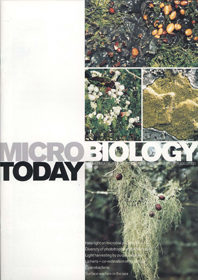Microbial phototrophs
01 August 2001 publication
The lead articles of the August 2001 issue of Microbiology Today are on seeing microbial phototrophs from a new light; the diversity of phototrophic sulfur bacteria; lichens; cyanobacteria; and surface warfare in the sea.
Shining a new light on microbial phototrophs – the second century (p. 115)
Sam Kaplan takes a look at the developments of our knowledge of phototrophic microbes and speculates on potential future research areas.
Diversity and ecology of phototrophic sulfur bacteria (p. 116)
Jorge Overmann explores the diversity and ecology of green and purple sulfur bacteria.
Light harvesting by purple bacteria: a circular argument (p. 120)
Richard Cogdell and Alastair Gardiner reveal the complexities of photosynthesis by purple bacteria.
Lichens and co-ordination of the symbionts (p. 124)
Lichens are a fascinating example of symbiosis, as well as providing useful indicators of atmospheric pollution. David Hill explores their biology.
Cyanobacteria: ecology, niche adaptation and genomics (p. 128)
Cyanobacteria can be found in virtually all ecosystem habitats. Dave Scanlan describes these adaptable microbes and introduces the most abundant photosynthetic organism on Earth.
How do cyanobacteria glide? (p. 131)
The mechanisms by which bacteria move are not all fully understood. David Adams considers the motility of cyanobacteria.
Surface warfare in the sea (p. 134)
How can a natural defence mechanism of seaweed be used to solve the problems caused by marine biofouling? Staffan Kjelleberg and Peter Steinberg desribe their investigations into biofilm inhibition.
Koch's colonies and the culinary contribution of Fanny Hesse (p. 136)
Today we take for ranted the culturing and isolation of micro-organisms on agar plates. Philip Mortimer describes the pioneers of these techniques.
Careers for microbiologists – or, what on earth am I doing here? (p. 138)
Peter Wyn-Jones covers the different career options for microbiologists.
Going Public (p. 140)
The Society is actively involved in promoting microbiology in schools, both alone and with other organisations. Dariel Burdass describes some of the recent activities, such as the World of Microbes workshops, and the MISAC 2001 Schools Competition: Microbes and Food. Joy Perkins and her colleagues at the University of Huddersfield bravely opened their labs to school students during National Science Week. This was assisted by a grant from the SGM Public Understanding of Science Fund.
Gradline (p. 155)
In this issue, the Society talks to Grace Alderson, Pro-Vice-Chancellor and Professor of Medical Microbiology at the University of Bradford, about a job in academic management.
Comment (p. 168)
TB seems to present a series of unending challenges to scientists. Johnjoe McFadden looks back at some triumphs in the fight and considers what benefits genomics may bring in the future.



